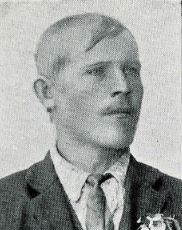
Frederick Charles Louis Constantine, Prince and Landgrave of Hesse, was the brother-in-law of the German Emperor, Wilhelm II. He was elected King of Finland on 9 October 1918, but renounced the throne on 14 December 1918.

The Finnish Workers' Sports Federation is a Finnish amateur sports organization founded in 1919. In addition to the competitive sports, TUL focuses on youth activities and youth education as well as offering activities regardless of age, gender, ethnicity or financial means. TUL is one of the member associations of the Finnish Olympic Committee.

Heikki Heikinpoika Lehmusto was a Finnish sports leader and a sportswriter, who won bronze in the 1908 Summer Olympics.
Johan Einar "Eino" Railio was a Finnish gymnast who won bronze in the 1908 Summer Olympics.

Viktor Reinhold Smeds was a Finnish sportsleader and a boxer, who also won an Olympic bronze in gymnastics.

Eino Vilho Forsström was a Finnish gymnast who won two medals in the 1908 and 1912 Summer Olympics.

Väinö Edward Tiiri was a Finnish gymnast who won two Olympic medals.
International Workers' Olympiads were an international sporting event arranged between 1925 and 1937 by Socialist Workers' Sport International (SASI). It was an organisation supported by social democratic parties and International Federation of Trade Unions. Workers' Olympiads were an alternate event for the Olympic Games. The participants were members of various labor sports associations and came mostly from Europe. Nowadays the CSIT World Sports Games are the successor sports events of the International Workers' Olympiads. The "World Sports Games" is the main highlight and a new brand of the International Workers and Amateurs in Sports Confederation (CSIT). It is a sports event for thousands of workers and amateurs held every two years. The CSIT is an international multi-sports organization.

Finnish Workers' Sports Federation football team was an association football team representing the Finnish Workers' Sports Federation (TUL) in 1921–1950. At the time, the sport in Finland was divided as the leftist TUL was isolated from the right-wing sports movement. In football, the TUL clubs and the Finnish Football Association (SPL) clubs competed in their own championship series and the Finland national football team was selected of the SPL players only. The TUL football team participated the International Workers' Olympiads in 1925, 1931 and 1937 and the Moscow Spartakiad in 1928.

1921 Workers' Olympiad was the first unofficial edition of the International Workers' Olympiads, organized by the 1920-established Lucerne Sport International and hosted by the Czechoslovakian Workers' Gymnastic Association in Prague, Czechoslovakia. The original scheduled date was August, but finally the games were held from 25 to 29 June 1921. The first official Workers' Olympiads were held in 1925 in Schreiberhau (Winter) and Frankfurt am Main (Summer) in Germany. The unofficial Czechoslovakian games were staged again in 1927 and 1934.
From 1906 to 1926, the Finnish Swimming Federation did not arrange a dedicated national competition, but spread out the hosting duties of the championship events to multiple clubs.
From 1906 to 1926, the Finnish Swimming Federation did not arrange a dedicated national competition, but spread out the hosting duties of the championship events to multiple clubs.
From 1906 to 1926, the Finnish Swimming Federation did not arrange a dedicated national competition, but spread out the hosting duties of the championship events to multiple clubs.
From 1906 to 1926, the Finnish Swimming Federation did not arrange a dedicated national competition, but spread out the hosting duties of the championship events to multiple clubs.
From 1906 to 1926, the Finnish Swimming Federation did not arrange a dedicated national competition, but spread out the hosting duties of the championship events to multiple clubs.
Arthur Frank Furze (1903–1982) was a male athlete who competed for England.

Ensio Ilmari Uoti was a Finnish politician and Nazi who in the 1930s was the leader of the Finnish-Socialist Workers' Party (SSTP).

Matti Pekanpoika Lonkainen was a Finnish smallholder, politician and member of the Parliament of Finland, the national legislature of Finland. A member of the Social Democratic Party, he represented Kuopio Province East between June 1909 and May 1918. He died in captivity following the Finnish Civil War.

Matti Turkia was a Finnish newspaper editor, politician and member of the Parliament of Finland, the national legislature of Finland. A member of the Social Democratic Party (SDP), he represented Uusimaa Province between October 1930 and April 1945. He had previously represented Viipuri Province West from May 1907 to May 1909 and from February 1914 to April 1917. He was secretary of the SDP from 1906 to 1918.

Väinö Kivisalo was a Finnish politician and member of the Parliament of Finland, the national legislature of Finland. A member of the Social Democratic Party, he represented Häme Province South between August 1929 and July 1948. Prior to being elected, he was imprisoned for political reasons following the Finnish Civil War.













